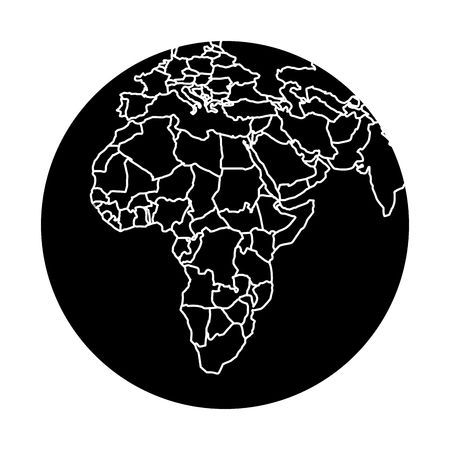1. The Origins of Coffee and Early Trade Routes
To truly understand how coffee became a global phenomenon, we need to start at the very beginning—East Africa. Most historians agree that coffee originated in Ethiopia, where legend tells of a goat herder named Kaldi who noticed his goats became unusually energetic after eating berries from a certain tree. This tree would later be identified as the Coffea plant.
From its humble beginnings in the Ethiopian highlands, coffee made its way across the Red Sea to the Arabian Peninsula, particularly Yemen, where it began its transformation from a local curiosity into a cultural staple. By the 15th century, Sufi monks in Yemen were drinking coffee to stay awake during long nights of prayer. They prepared it by roasting and brewing the beans much like we do today, marking the birth of coffee culture as we know it.
The Arabian Coffee Trade
Coffee quickly spread through the Islamic world via trade routes connecting cities like Mecca, Medina, and Cairo. The port city of Mocha in Yemen became especially significant—it was one of the earliest and most important centers for coffee trade. In fact, the term “mocha” that we use today for chocolate-flavored coffee drinks originally referred to this port.
Coffee Reaches Europe
By the 17th century, European travelers and traders encountered coffee in their journeys through the Ottoman Empire. Venetian merchants brought it back to Italy, where it gained popularity among the upper classes before spreading across Europe. Coffee houses began popping up in major cities like London, Paris, and Vienna, becoming hubs for socializing and intellectual discussions—earning nicknames like “penny universities.”
Coffees Early Spread: A Timeline
| Region | Time Period | Key Events |
|---|---|---|
| Ethiopia | 9th Century (legend) | Discovery of coffee by Kaldi |
| Yemen | 15th Century | First cultivation and brewing practices |
| Ottoman Empire | 16th Century | Coffee spreads through Islamic world |
| Europe | 17th Century | Coffee introduced via trade; coffee houses established |
Cultural Impact
The early spread of coffee set the stage for what would later become a global industry deeply tied to colonialism, capitalism, and international politics. Its journey from Ethiopia to Europe reflects not just trade dynamics but also cultural exchange and adaptation. Coffee was more than just a drink—it became a symbol of energy, intellect, and even rebellion in some circles.
2. European Colonial Powers and the Coffee Boom
As coffee spread from its origins in Ethiopia and Yemen, it quickly caught the attention of European colonial powers looking to expand their wealth and influence. The Dutch, French, Portuguese, and British all played key roles in shaping the global coffee trade. But this expansion wasnt just about introducing a beloved beverage—it was also about control. Coffee plantations became powerful tools for economic domination across Asia, Africa, and the Americas.
The Dutch: Java and Global Distribution
The Dutch were among the first Europeans to commercialize coffee outside its native regions. In the 17th century, they successfully cultivated coffee in Java (modern-day Indonesia), turning it into one of the first major coffee-exporting colonies. They built an extensive trading network through the Dutch East India Company (VOC), using forced labor systems to keep production costs low and profits high.
Key Impacts of Dutch Colonization:
| Region | Strategy | Impact |
|---|---|---|
| Java (Indonesia) | Forced cultivation under VOC control | Massive exports to Europe; exploitation of local farmers |
| Amsterdam | Global trading hub for coffee | Became a center for coffee auctions and pricing |
The French: Caribbean Plantations and Slave Labor
The French took their coffee ambitions to the Caribbean, especially to colonies like Saint-Domingue (now Haiti) and Martinique. By the 18th century, these islands were producing vast amounts of coffee using enslaved African labor. Saint-Domingue alone supplied nearly half of the world’s coffee before the Haitian Revolution.
Coffees Role in French Colonies:
- Economic Engine: Coffee exports fueled France’s economy during the colonial era.
- Social Impact: Harsh plantation conditions led to uprisings and ultimately revolution.
- Legacy: After independence, Haiti’s coffee industry declined due to political instability and lack of colonial support.
The Portuguese: Brazil’s Coffee Empire
The Portuguese established what would become the world’s largest coffee-producing nation—Brazil. Starting in the early 18th century, they expanded plantations across the southeastern region of Brazil using enslaved Africans as labor until slavery was abolished in 1888. Even after abolition, exploitative labor systems persisted under different forms.
Brazilian Coffee Boom Highlights:
| Period | Development | Effect on Global Trade |
|---|---|---|
| 1700s–1800s | Expansion of large-scale plantations using slave labor | Became primary supplier for U.S. and European markets |
| Post-1888 | Migrant labor systems replaced slavery | Sustained Brazil’s dominance in global supply chain |
The British: Control Through Trade Networks
The British didn’t focus as much on growing coffee as they did on controlling its trade routes. However, they did experiment with cultivation in parts of India, Sri Lanka (then Ceylon), and Kenya. While tea eventually overshadowed coffee in many British colonies, their infrastructure investments helped globalize both commodities.
Main British Contributions:
- India & Sri Lanka: Introduced Arabica varieties; later shifted focus to tea due to disease outbreaks in coffee crops.
- Africa (Kenya): Established large-scale farms run by British settlers; indigenous people were often displaced or forced into labor roles.
- Global Trade: London became a financial center for international commodity trading, including coffee futures.
Coffees journey through colonial empires reveals how deeply intertwined it is with systems of power, exploitation, and economic ambition. While its now enjoyed casually at cafés and homes around the world, its history is anything but simple.

3. Forced Labor and Land Displacement on Coffee Plantations
As coffee spread globally under colonial rule, its success came with a heavy human cost. Behind the rising demand for coffee in Europe and North America was a system built on the backs of indigenous peoples, enslaved Africans, and displaced communities. Colonial powers didn’t just introduce coffee to new regions—they reshaped entire societies to serve the growing appetite for this commodity.
The Role of Enslaved Labor
During the height of European colonization, coffee plantations thrived in regions like the Caribbean, Brazil, and parts of Africa largely due to enslaved labor. These individuals were forced to work long hours under brutal conditions, often with little or no compensation. The labor was grueling—planting, harvesting, processing—and required year-round attention. For many enslaved people, life on a coffee plantation meant generations of exploitation and suffering.
Examples of Regions Using Enslaved Labor
| Region | Colonial Power | Labor Source |
|---|---|---|
| Brazil | Portugal | Enslaved Africans |
| Caribbean (e.g., Haiti) | France | Enslaved Africans |
| Ceylon (Sri Lanka) | Britain | Tamil indentured workers |
Displacement of Indigenous Communities
Coffee’s expansion also led to widespread land displacement. In Latin America, Africa, and Southeast Asia, colonial governments and settlers seized fertile land from indigenous communities to make way for large-scale plantations. These lands were often taken without consent or compensation, disrupting local economies and cultural practices that had existed for centuries.
The Impact on Indigenous Peoples
- Loss of Land: Communities lost access to ancestral territories used for farming, hunting, and spiritual practices.
- Forced Labor Systems: In some regions like Guatemala and Kenya, indigenous people were forced into labor through systems like debt peonage or imposed taxes payable only through plantation work.
- Cultural Erosion: With land loss came the erosion of traditional ways of life as communities became dependent on colonial economies.
A System Built on Inequality
The global expansion of coffee was not just about agriculture—it was about power. Colonial powers created economic systems where wealth flowed back to Europe while those producing the coffee remained in poverty. This legacy still affects many coffee-growing countries today, where farmers struggle with low wages and lack of land ownership.
A Closer Look: Colonial Coffee Economics
| Coffee-Producing Country (Colonial Era) | Main Beneficiary | Main Labor Force |
|---|---|---|
| Ethiopia (Italian occupation) | Italy | Local populations under coercion |
| Indonesia (Dutch East Indies) | The Netherlands | Javanese forced laborers |
| Cuba (Spanish colony) | Spain | African slaves and Afro-Cuban workers |
The darker side of coffee’s past is often left out of mainstream narratives. Understanding this history helps us appreciate not just the beverage itself but also the resilience of communities who endured injustice so that others could enjoy it.
4. The Legacy of Colonialism in Today’s Coffee Industry
Although colonial empires have long since fallen, the coffee industry still carries many of their imprints. From how coffee is grown and traded, to who profits most from its sale, the legacy of colonialism continues to shape the global coffee market in powerful ways.
Production Patterns Rooted in the Past
During colonial times, European powers set up large-scale plantations in countries with ideal climates for coffee growing—mostly in Africa, Latin America, and Southeast Asia. These regions remain the worlds top coffee producers today. However, the ownership and benefits from these farms often still lie outside local communities. The system was designed to extract resources and wealth from colonized lands, and that model hasn’t entirely disappeared.
Supply Chains Built on Inequality
The modern coffee supply chain is long and complex, often involving multiple middlemen before the beans reach consumers. Farmers at the start of this chain typically earn the least. Many smallholder farmers live below the poverty line, while big corporations dominate roasting, branding, and retail—where most profits are made. This imbalance mirrors the economic structures established during colonial rule.
Who Gets What: A Look at Coffee Profits
| Stage | Stakeholder | Typical Share of Profit |
|---|---|---|
| Cultivation | Smallholder Farmer | 5%–10% |
| Processing & Exporting | Local Middlemen/Exporters | 10%–15% |
| Importing & Roasting | International Companies | 30%–40% |
| Retail Sales | Global Brands & Retailers | 40%–55% |
Inequality Among Coffee-Producing Nations
The disparities between coffee-producing countries can also be traced back to colonial times. Countries that were heavily colonized often lack infrastructure or local processing facilities needed to add value to their coffee exports. This forces them to sell raw beans cheaply instead of roasted or packaged products that fetch higher prices. Meanwhile, former colonial powers have developed strong branding and marketing industries that dominate global coffee culture today.
A Continuing Struggle for Fairness
Efforts like Fair Trade and Direct Trade aim to address some of these inequalities by paying farmers better prices and encouraging more transparent supply chains. But these initiatives are still a small part of a much larger system influenced by centuries-old practices. Understanding this history helps us see why change is slow—and why it’s so necessary.
5. Decolonizing Your Cup: Ethical Consumption and Fair Trade
As more Americans learn about coffee’s colonial past, there’s a growing desire to make better choices when buying that daily cup of joe. This movement is part of whats known as conscious consumerism—a shift toward purchasing goods that align with ethical, social, and environmental values.
What Is Conscious Consumerism?
Conscious consumerism means being aware of the impact your purchases have on people and the planet. When it comes to coffee, this involves considering how beans are grown, who grows them, and under what conditions. Its about asking questions like: Was the farmer paid fairly? Were sustainable farming methods used? Did the company prioritize community development?
The Role of Fair Trade
One of the most well-known ways to support ethical coffee production is by choosing Fair Trade Certified products. Fair trade ensures that farmers are paid a minimum price for their crops, which helps protect them from volatile market shifts. It also promotes safe working conditions, environmentally friendly farming practices, and investments in local communities.
Key Benefits of Fair Trade Coffee
| Benefit | Description |
|---|---|
| Fair Wages | Farmers receive stable pricing above market rates, reducing poverty and exploitation. |
| Community Investment | Portions of profits go into education, healthcare, and infrastructure projects in farming communities. |
| Sustainability | Coffee is grown using eco-friendly practices that reduce deforestation and chemical use. |
| Empowerment | Small-scale farmers gain more control over their businesses and futures. |
How You Can Make a Difference
You don’t need to be an expert to support ethical coffee. Small changes in your buying habits can have a big impact. Here are a few simple steps:
Tips for Ethical Coffee Consumption
- Look for certifications: Choose brands that carry Fair Trade, Rainforest Alliance, or Direct Trade labels.
- Support local roasters: Many small roasters work directly with farms and provide transparency about sourcing.
- Ask questions: Don’t be shy—ask your barista or favorite café where their beans come from.
- Avoid ultra-cheap coffee: If it seems too cheap to be true, chances are someone didn’t get paid fairly along the way.
- Educate yourself: Learn about the origins of your coffee and share what you know with others.
A Shift Toward Equity in Every Sip
The story of coffee’s global journey is deeply tied to colonization and exploitation. But today, consumers have the power to reshape that narrative by choosing coffee that supports dignity, fairness, and sustainability. One cup at a time, we can help decolonize the industry—starting right here at home.

